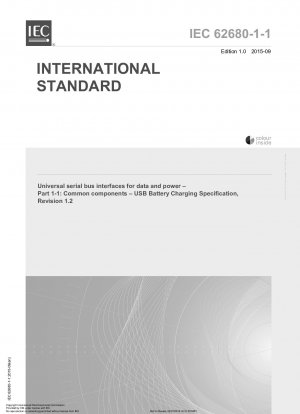IEC 62680-1-1:2015
Universal serial bus interfaces for data and power - Part 1-1: Common components - USB Battery Charging Specification, Revision 1.2
- Standard No.
- IEC 62680-1-1:2015
- Release Date
- 2015
- Published By
- International Electrotechnical Commission (IEC)
- Latest
- IEC 62680-1-1:2015
- Replace
- IEC 100/2330/CDV:2014
- Scope
- The Battery Charging Working Group is chartered with creating specifications that define limits as well as detection, control and reporting mechanisms to permit devices to draw current in excess of the USB 2.0 specification for charging and/or powering up from dedicated chargers, hosts, hubs and charging downstream ports. These mechanisms are backward compatible with USB 2.0 compliant hosts and peripherals. Background The USB ports on personal computers are convenient places for Portable Devices (PDs) to draw current for charging their batteries. This convenience has led to the creation of USB Chargers that simply expose a USB standard-A receptacle. This allows PDs to use the same USB cable to charge from either a PC or from a USB Charger. If a PD is attached to a USB host or hub, then the USB 2.0 specification requires that after connecting, a PD must draw less than: 2.5 mA average if the bus is suspended; 100 mA if bus is not suspended and not configured; 500 mA if bus is not suspended and configured for 500 mA If a PD is attached to a Charging Port, (i.e. CDP, DCP, ACA-Dock or ACA), then it is allowed to draw IDEV CHG without having to be configured or follow the rules of suspend. In order for a PD to determine how much current it is allowed to draw from an upstream USB port, there need to be mechanisms that allow the PD to distinguish between a Standard Downstream Port and a Charging Port. This specification defines just such mechanisms. Since PDs can be attached to USB chargers from various manufacturers, it is important that all provide an acceptable user experience. This specification defines the requirements for a compliant USB charger, which is referred to in this spec as a USB Charger. If a PD has a Dead or Weak Battery, then the Connect Timing Engineering Change Notice (ECN) issued by the USB-IF on the USB 2.0 spec allows that device to draw up to IUNIT while attached but not connected.
IEC 62680-1-1:2015 history
- 2015 IEC 62680-1-1:2015 Universal serial bus interfaces for data and power - Part 1-1: Common components - USB Battery Charging Specification, Revision 1.2
